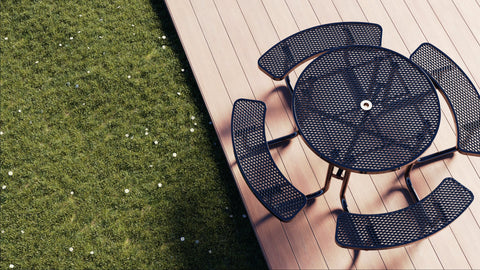Polyethylene-Coated Steel vs. Aluminum Outdoor Furniture: Which Material Wins?
When choosing durable seating and tables for parks, campuses, restaurant patios or corporate courtyards, you’ll often weigh polyethylene-coated steel against aluminum. Both metals resist corrosion and look great, but they differ in performance under heavy use and changing weather. Here’s how they measure up.
1. Durability Comparison
-
Aluminum is naturally rust-proof and lightweight, making it easy to move into damp or coastal climates. However, it dents and bends more easily under rough handling or high foot traffic.
-
Polyethylene-Coated Steel combines a strong steel core with a plastic-like barrier that seals out moisture, graffiti and scratches. This construction holds up for decades in heavy-use environments.
Best Choice for Tough Use: Polyethylene-coated steel.
2. Weight and Security
-
Aluminum furniture is light enough for quick setup at events but can be tipped or stolen more easily in public areas.
-
Coated Steel is heavier by nature, resisting wind and vandalism while providing a stable, secure installation in parks and schoolyards.
3. Maintenance and Appearance
-
Aluminum will not rust, yet its finish can oxidize, fade or show scratches. Once the protective layer wears off, corrosion may begin.
-
Polyethylene-Coated Steel features a thick, UV-resistant finish that repels moisture and graffiti. A simple soap-and-water wash restores its original look without repainting.

4. Comfort and Safety
-
Aluminum surfaces heat up quickly in sun and chill in cold, and thinner frames can present sharp edges around children.
-
Coated Steel offers smooth edges, rounded corners and a slightly cushioned feel, making it safer and more comfortable year-round.
5. Style and Color Options
-
Aluminum provides a sleek, minimalist look but is usually limited to a few colors; refreshing the hue requires professional repainting.
-
Polyethylene-Coated Steel comes in vibrant, fade-resistant shades—playground bright reds, deep navies for coastal parks or custom brand colors—that maintain their finish without frequent touch-ups.
6. Long-Term Value
-
Aluminum has a lower initial cost but can require more frequent replacement and upkeep in commercial or public settings.
-
Coated Steel demands a slightly higher upfront investment yet delivers minimal maintenance, fewer replacements and a lower total cost of ownership over time.
Conclusion
For light residential use, aluminum may be adequate. Nonetheless, coated metal furniture can be considered an excellent choice if you have multi-year durability in mind. For high-traffic, all-weather public spaces where longevity and low maintenance are critical, polyethylene-coated steel clearly outperforms. Browse our full range of coated steel picnic tables, benches and accessories to find the perfect solution for your outdoor setting.


